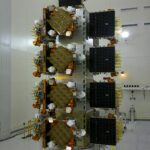
The Air Force has submitted plans to the White House to begin transferring its space-related capabilities to the forthcoming Space Force next fiscal year, according to a memo obtained by Defense Daily. A Dec. 2 memo from Air Force Secretary Barbara Barrett to Deputy Secretary of Defense David Norquist involves the Air Force’s recommendation for a U.S. Space Force Presidential Budget 2021 (PB21) submission, and includes expectations for when agencies and non-Air Force space-related programs might move into the new…

 By
By 










